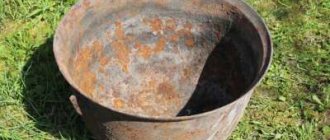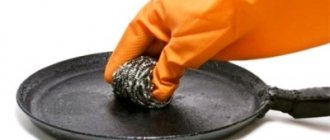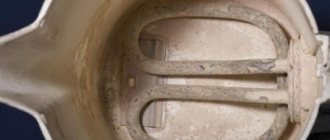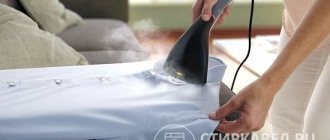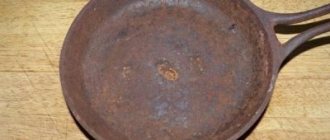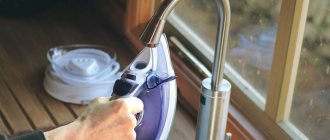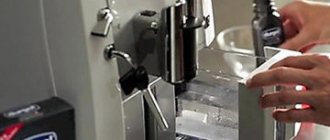The thermopot successfully combines the functions of an electric kettle and a thermos. The water in it boils quickly and remains hot for a long time.
In order for the device to function properly, limescale must be removed from it regularly.
Read the article about how to descale a thermopot at home using household chemicals and proven folk recipes.
Where does scale come from and why is it dangerous?
Such deposits are formed due to poor quality drinking water. Due to the fact that it goes through many stages of purification, inclusions of calcium and magnesium settle in tap water. During boiling, they turn into dangerous carbon dioxide, which is why a solid alkaline precipitate of lime is obtained. It settles inside the device.
Scale is fraught with the following problems:
- water heating is slow;
- increased energy consumption;
- loud noise when the equipment is operating;
- unpleasant taste.
You will be surprised, but the first cleaning will need to be done a few months after using a completely new device. It is then that it will not be difficult to notice that different light and dark stripes began to appear inside. So it's time to act!
Ignoring the problem will result in the unit having to be replaced. But all that was needed was to carry out the correct cleaning work. We'll tell you how to do this correctly.
How to remove with household chemicals?
You can deal with scale using professional cleaners, which are sold in household chemical stores and online markets. The most effective formulations:
- Topperr for kettles and water heaters. For 1 liter of water you will need 100-120 ml of solution. The liquid is heated to 50 degrees, left for half an hour and drained. The container is boiled with clean water. The product is non-toxic and is gentle on device parts. The cost of 250 ml of solution is 145 rubles.
- Filtero anti-scale tablets for teapots and thermopots. The device is filled 3/4 with water and brought to a boil. Place the tablet inside and leave for 20 minutes. If the plaque layer is thick, use 2 pieces. The solution is drained and the thermopot is rinsed with clean water. The cost of 6 tablets is 110 rubles.
- Mellerud for quick descaling. Pour 0.5 liters of water into the device and add 120 ml of solution. Bring the mixture to a boil, leave for 15 minutes, and drain. Rinse the device with plenty of clean water. The cost of 500 ml of solution is 282 rubles.
It is unacceptable to violate the manufacturer's instructions. Professional household chemicals contain acids, which can damage the walls of the thermopot during prolonged contact.
Professional help
You can clean the thermopot from scale either using special detergents or using proven methods from the people. In the first case, we are talking about professional tools (take SVOD-TVN as an example). Such preparations are sold in the household chemicals department. What are they good for? The composition of the products includes substances that fight against corrosive manifestations, organic and inorganic acids.
List of advantages:
- gentle removal of plaque without damaging the inner surface;
- health safety.
However, to comply with the last point, the device should be rinsed thoroughly. This diligence is necessary to ensure that chemical residues do not damage the sealing elements.
Another recommendation is to follow the instructions exactly, especially maintaining the required time for the product to completely remove scale.
Helpful information
Tips that will be useful to all owners of thermopots:
When processing the device, do not use metal sponges or sharp objects. They can damage the inner surface of the device.- Preventive cleaning is carried out at least once a month. Folk remedies are used for this purpose.
- In order to remove a thick layer of scale, they resort to the help of professional household chemicals.
- If cleaning liquid has been poured into the device, household members must be informed about this in order to avoid accidental poisoning.
- After completing cleaning, it is better not to just rinse the device, but to boil it. The first water is not used for drinking, it is drained.
You can learn about descaling from various household appliances here.
Effective folk remedies
Such methods are popular because they are available in every home and do not require special material costs. The most popular are table vinegar, citric acid, baking soda, cucumber pickle, and carbonated drinks.
Cleaning with acetic acid
To remove scale from a thermopot with acetic acid, simply fill the flask with a solution made in the proportion of 1 liter of water to 50 ml of vinegar. All that remains is to bring the vinegar to a boil and leave the contents for a couple of hours.
When cleaning with vinegar, you can avoid a specific odor: to do this, just boil it with the lid open . Of course, you will have to thoroughly rinse the unit more than once. This method will help to cope even with old deposits.
Citric acid with soda
If there are not too many deposits, you can descale the thermopot with such a popular remedy as citric acid mixed with soda. You need to pour water inside, then add 20 g of baking soda and stir everything. Boil and leave to cool. After half an hour, the contents are drained and the unit is filled with water again. Now boiling should take at least 25 minutes.
After the procedure, the contents are drained, the flask is rinsed, and the device is wiped dry with a sponge. If the result does not suit you, then the procedure should be repeated.
By the way, you can use each substance separately.
Help from cucumber pickle
The vinegar contained in the marinade helps remove the problem. The brine is boiled for 20 minutes - during this time the scale should come off. To ensure that no characteristic odor remains, after draining the contents, the device should be rinsed thoroughly under running tap water.
Carbonated products
The use of drinks like Coca-Cola, Sprite, Pepsi-Cola and so on also shows good results. You need to do this.
- The drink is left open - this is necessary so that the gases come out of it. Usually 20 minutes is enough.
- Now pour it into the thermopot to be cleaned (fill half of the internal space). All that remains is to boil.
- Drain and remove the residue with a sponge.
A small but important recommendation is that it is better to choose Spryte for cleaning as it is dye-free. Pepsi and Coca-Cola will need additional cleaning to remove their dyes.
How to clean limescale in an electric kettle using household chemicals
Let's look at the procedure for processing a plastic and metal kettle.
Cleaning a plastic electric kettle from scale
To get rid of dirt in a plastic product, do not use soda and vinegar. But citric acid will do the job perfectly. The method is universal; it is suitable for both metal coatings and plastic.
How to clean a microwave: recommendations, 6 proven methods, proven remedies
If a thin layer of deposits is noticeable on the walls and spiral of the kettle, then you don’t have to boil the water. It is necessary to measure 1 liter of clean water, pour 20 g of lemon crystals into it, and mix. The resulting mixture is poured into the device and left to soak. Most often, 3-4 hours are enough. The deposits should fall off on their own.
If this does not happen, then you need to turn on the equipment and wait for it to boil. Now removing all the scale will not be difficult.
To get rid of dirt in a plastic product, do not use soda and vinegar.
How to clean a metal electric kettle
To avoid problems with malfunctions of a metal device, you need to take care of it and clean it in a timely manner. But if scale has formed, it is recommended to use the following instructions:
- The electrical appliance is disconnected from the network. It needs to cool down;
- When cleaning, use mechanical or chemical methods. The first may complement the other. To get rid of carbon deposits, brushes made of artificial bristles, wood, plastic, and silicone are used manually. The surface treatment of the water heating element must be carried out carefully; scale must be removed evenly. If deposits remain, the water will heat unevenly, energy consumption will increase, and the device may burn out. Under no circumstances should you use sandpaper or a file - there is a high probability of damaging the metal coating. The next layer, which will fall on the previous one, will be very difficult to wipe off;
- In the chemical method, acids and solvents are used. Treatment with agents, depending on the concentration, can be regular or urgent radical;
- The electric device is equipped with a mesh closer to the spout, which prevents sediment from penetrating into the mug. This filter must be cleaned regularly.
Having finished scrubbing the kettle of scale, boil the water in it twice. Rinsing occurs under running water.
To avoid problems with malfunctions of a metal device, you need to take care of it and clean it in a timely manner.
When using tap water, the electric kettle quickly becomes covered with a layer of plaque. This is explained by the fact that when boiling, a lot of salts are released, which gradually settle on the walls of the device and the heating element. Not everyone understands the seriousness of this problem. Contamination not only reduces the service life of equipment, but also deteriorates human health.
It is important to timely treat the internal surface of an electrical appliance.
Glass
To clean heat-resistant glass teapots, do not use steel wool, sand, or abrasives. It is better to use chemicals that remove grease well. Grease stains come off easily if you wash with hot water and a spoonful of dry mustard.
Enameled
Rusty stains from the enamel of the kettle are removed with a swab dipped in vinegar. Grease stains are washed off with warm water and mustard powder. It removes grease and dirt from the outside well if you clean it with a paste of baking soda and soap. You can clean the top of the dishes with fine salt applied to a damp sponge or cloth.
Emergency cleaning
In advanced cases, you will need to act in a special way. One of the following methods will come in handy.
- Add a tablespoon of baking soda to a thermopot filled with water. Then the solution is boiled for at least half an hour, followed by draining and washing.
- Water and citric acid are added to the thermopot. All this boils for half an hour. The solution is drained.
- You can add a tablespoon of acetic acid and boil for half an hour. Drain the contents and rinse the device.
How to descale a thermopot with citric acid
A good and safe way to clean a thermopot at home is to use citric acid and soda. If there is only a little scale, it is enough to clean the device once every 10 days and you will not have to spend money on expensive cleaners.
The whole process is as simple as possible, just follow the step-by-step instructions:
The advantage of cleaning a thermopot or electric kettle with citric acid is that it is odorless and environmentally friendly for humans. The downside is that this method is only suitable for small stains.
Helpful advice! From personal experience, I can recommend cleaning the device once a week. Just citric acid and boiling once is enough to make the inside of the device look like new. In addition, this product is safe not only for humans, but also for the device.
Some Important Recommendations
Before cleaning the thermopot, read the following rules - this will help you carry out the cleaning correctly and without harm to the equipment.
- When using vinegar essence, it is not necessary to boil it - just add the product to the water and wait until the scale dissolves completely.
- It is not advisable to use concentrated food acids. And strong ones like sulfuric and hydrochloric acid are completely prohibited.
- There is also a taboo on the use of abrasives, for example, a wire brush or sandpaper - this can simply break the heating element.
- It is better to use filtered water - this will delay the appearance of scale.
- After cleaning with any means, pour clean water into the thermopot, boil again and drain. Remove any unwanted residue. Better yet, do this several times.
Careful treatment of the device and timely preventive measures are the key to its long and effective service. Any user can do this type of cleansing.
Baking soda
This remedy is used in cases where the plaque is insignificant. The instructions are:
- Water is poured into the thermopot (to the top).
- For each liter, take 1 large spoon of soda.
- The mixture is thoroughly mixed.
- Then you need to boil the solution and drain it, then rinse the thermopot.
If the scale is not completely gone the first time, you need to repeat the procedure again. Soda is not a very effective remedy; it only copes with a small layer of scale. But it does not leave any odors and, moreover, disinfects internal surfaces.
Peel raw potatoes
The main vegetable of Irish cuisine, potatoes, are an excellent way to clean a thermopot. Just:
- You put the peeled, well-washed potatoes into the hybrid device.
- You pour water and boil it.
- After half an hour, you take some kind of spoon (preferably a wooden one, so as not to damage the walls) and clean off the now very pliable scale.
If the plaque continues to persist and does not want to soften, it makes sense to keep the “potato” water inside the device for 8-10 hours. Then even the most stubborn residue will be removed like a charm.
Another interesting article: How long do fresh champignons last in the refrigerator?
How to remove with household chemicals?
You can deal with scale using professional cleaners, which are sold in household chemical stores and online markets. The most effective formulations:
- Topperr for kettles and water heaters. For 1 liter of water you will need 100-120 ml of solution. The liquid is heated to 50 degrees, left for half an hour and drained. The container is boiled with clean water. The product is non-toxic and is gentle on device parts. The cost of 250 ml of solution is 145 rubles.
- Filtero anti-scale tablets for teapots and thermopots. The device is filled 3/4 with water and brought to a boil. Place the tablet inside and leave for 20 minutes. If the plaque layer is thick, use 2 pieces. The solution is drained and the thermopot is rinsed with clean water. The cost of 6 tablets is 110 rubles.
- Mellerud for quick descaling. Pour 0.5 liters of water into the device and add 120 ml of solution. Bring the mixture to a boil, leave for 15 minutes, and drain. Rinse the device with plenty of clean water. The cost of 500 ml of solution is 282 rubles.
It is unacceptable to violate the manufacturer's instructions. Professional household chemicals contain acids, which can damage the walls of the thermopot during prolonged contact.
